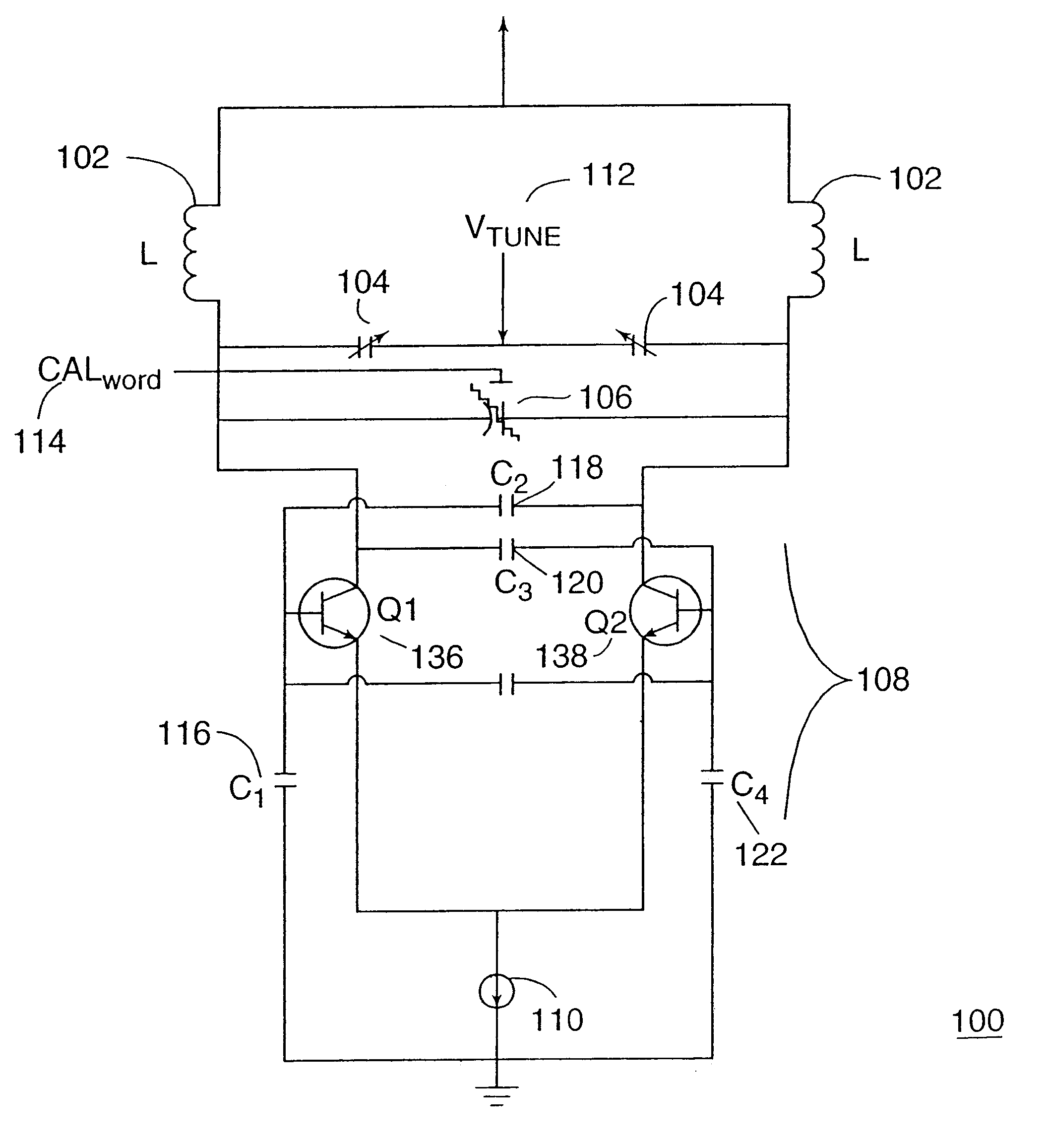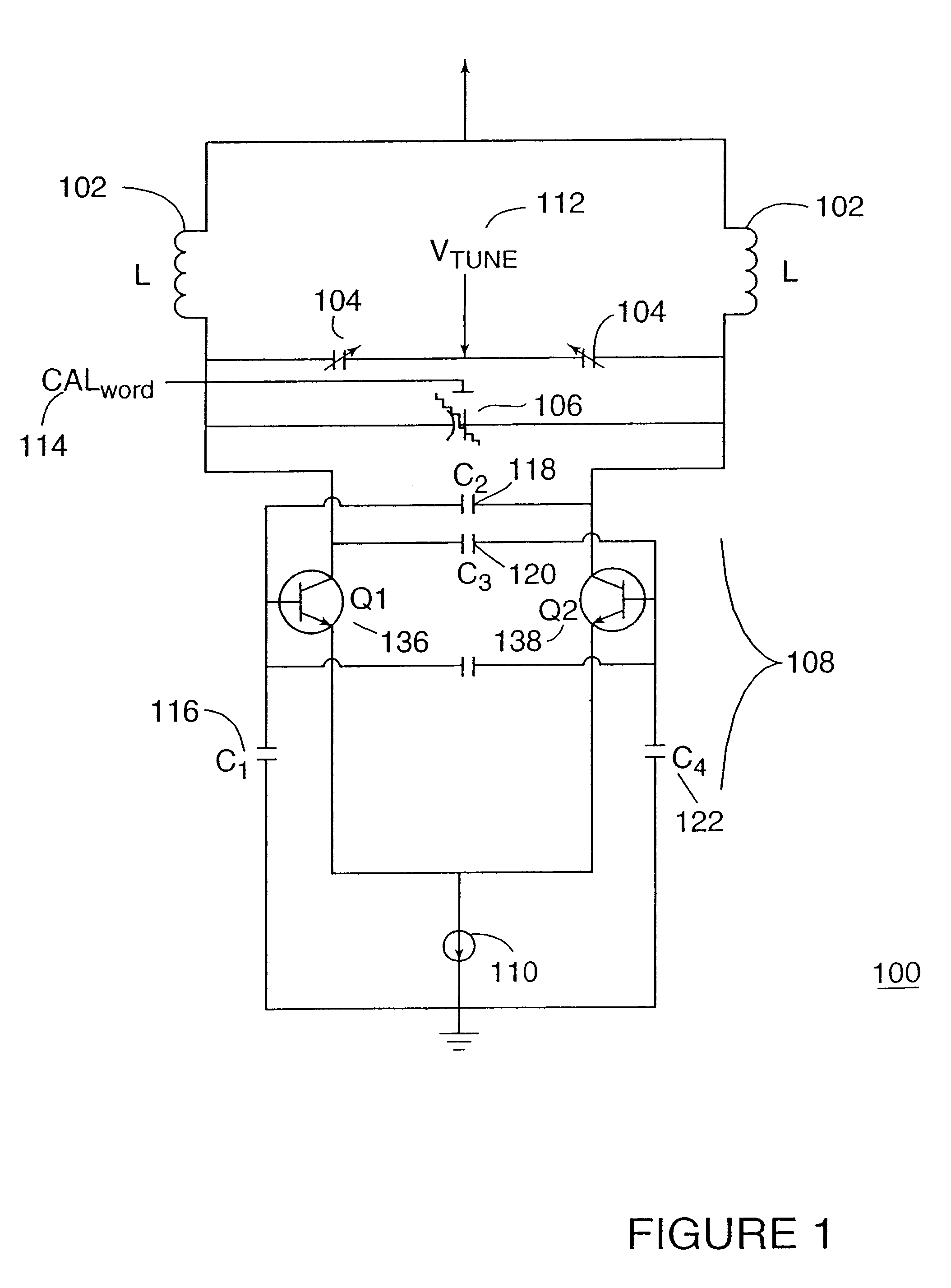One well-known problem to those skilled in the art of the design and manufacture of integrated circuits is the poor tolerance values associated with integrated circuit components, especially the tolerance values of passive circuit components.
Consequently, it has proven difficult and costly in the past to implement tuned networks or circuits using on-
chip passive electrical components.
Disadvantageously, the trimming techniques produce only static solutions.
For example, in fuse trimming, although the devices may perform adequately under nominal conditions, they may not perform adequately under all of the operating conditions of the integrated circuit.
However, disadvantageously, the integrated circuit is permanently configured once the fuses are blown.
Devices that were once
usable under the nominal conditions at which the fuses were blown may become unusable under some operating conditions, thus adversely affecting yield characteristics of the integrated circuits.
In addition, the prior art post-fabrication solutions disadvantageously introduce additional manufacturing and testing steps into the manufacturing process.
Thus, the prior art post-fabrication trimming techniques add additional time to the design and fabrication of integrated circuit devices and consequently add to the manufacturing costs of the integrated circuits.
Disadvantageously, when the VCO is implemented in an integrated circuit, poor tolerance values due to IC fabrication process variations and other factors can adversely affect the previously tuned
center frequency.
Consequently, the prior art VCO integrated circuit implementations disadvantageously require calibration to re-center the LC-
resonator circuit's
resonance frequency to a desired
center frequency value.
Due to variations from part to part, the prior art IC VCO implementations may be unreliable and totally unusable, especially when operating at high frequencies.
This limitation in the prior art IC VCO implementations also disadvantageously limits the frequency range over which the VCO can be tuned (the VCO tuning range).
However, due to process variations and other factors, the tuning ranges of the prior art IC VCO implementations are limited even further.
In addition to variations in desired center frequencies, the prior art IC VCO implementations disadvantageously are also very sensitive to
low frequency noise that is introduced into the IC substrate.
This sensitivity to
noise characteristic not only further limits the prior art VCO tuning ranges, but it also severely limits the utility of the prior art VCO designs in some important applications, such as use in a mixed
signal (analog and digital) integrated circuit environment.
This non-linear well-substrate junction
capacitance is particularly problematic in IC VCO implementations.
Furthermore, due to the well-substrate junction of prior art designs, the total
parasitic capacitance is also increased.
Increased
parasitic capacitance disadvantageously also decreases the tuning range of the IC VCO implementations.
Consequently, due to the well-substrate junctions of the prior art IC VCO designs, the VCO center output frequencies have proven unreliable from part to part, and they also are not amenable for use in a mixed
signal environment.
Low frequency noise caused by
digital circuitry located elsewhere on the integrated circuit disadvantageously is introduced into the substrate and propagates through the substrate to the VCO, whereat it FM-modulates the VCO center output frequency.
This renders these prior art IC VCO designs useless for some applications where the center output frequency must be tightly controlled such as in
wireless communication systems.
In addition, the traditional varactors were limited in that they could only change
capacitance values by at most a factor of 1 / 2 per
octave, which, in turn, caused the tuning range of the VCO to be limited to a factor of 1 / 2 per
octave.
The prior art tuning varactors therefore further limited the tuning range of the VCO.
In addition, the prior art VCO designs disadvantageously create a forward bias conduction of current that is applied to the varactors due to the large swings experienced by the prior art VCO designs.
Disadvantageously, the forward bias conduction of current reduces the effective Q of the tank circuit in the VCO.
Low Q values of the inductors produce increases in
phase noise and frequency errors.
In addition, for the reasons provided above, the inductors also add parasitic capacitance to the IC due to the existence of low-resistivity substrates used in the prior art implementations.
Further, the local oscillation (LO)
radiation produced by the prior art inductors disadvantageously radiate down into the IC substrate and thereby introduce undesirable
noise energy into the substrate.
Not only does this detrimentally affect the performance of the VCO (by further limiting the tuning range), the radiated
noise energy detrimentally affects other circuits in the IC.
This can be especially detrimental in a mixed
signal IC.
The inductors in the prior art IC VCO designs consequently further limited the performance, utility, and tuning range of the prior art IC VCO implementations.
Consequently, the analog tuning varactor reduces the sensitivity of the VCO to
low frequency energy occurring in the IC substrate.
However, any noise present on the
analog control line will FM-modulate the VCO output frequency.
However, it will not significantly FM-modulate the VCO output frequency.
Disadvantageously, when the VCO is implemented in an integrated circuit, poor tolerance values due to IC fabrication process variations and other factors can adversely affect the desired tuned
center frequency.
Consequently, the prior art IC VCO disadvantageously are unreliable due to variations between integrated circuits.
In addition, as described above, use of the analog tuning varactor for fine-tuning the output frequency of the VCO also reduces the VCO
noise sensitivity.
 Login to View More
Login to View More  Login to View More
Login to View More 


